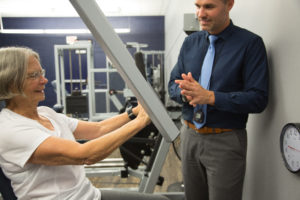Why Older Folks Have To Lift Weights
If you are 60 or older, lifting weights regularly is an absolute requirement for optimal health. In fact, it’s the most important thing you can do to maintain your independence in the eighth and ninth decades of your life.
At about age 30, all of us start losing muscle and strength at a rate of 3 to 5% every decade. At age 50, the loss increases to about 8% per decade. Most people lose more than 50% of their muscle mass by the time they reach their 80s. Given that about 60% of your body is muscle, losing 50% of this critical tissue will lead to all sorts of functional problems and medical issues.

Sarcopenia is the medical term that describes this age-related loss of muscle and strength. A clinical diagnosis of sarcopenia is determined when walking speed and grip strength decline dramatically. Over 50% of folks over 80 have a clinical diagnosis of sarcopenia, which robs many people of their ability to function independently.
Also, when you lose muscle, a host of other problems pop up. The amount of muscle you have is the largest predictor of your metabolism, so as you lose muscle it becomes more difficult for you to maintain a healthy percentage of body fat. Also, muscle loss is almost always associated with fat gain.
The combination of muscle loss and fat gain also tends to make us more insulin resistant and much more likely to develop type 2 diabetes. Muscle is your body’s most responsive tissue to insulin. When you have less muscle to store blood sugar, insulin moves on to store sugar in the next most responsive tissue, which is fat.
The combination of muscle loss, fat gain, and insulin resistance typically progresses to metabolic disorders and cardiovascular disease.
It doesn’t have to be this way. Adults at any age, especially older adults, respond extremely well to strength training. It does not matter how old you are, strength training will make you stronger and more muscular, which directly improves your overall health.
Healthy men between the ages 60 and 72 years who performed traditional strength training for 12 weeks demonstrated how well older adults respond to resistance training. They were able to improve muscle strength at a rate of 5% per training session, which matches typical strength gains reported for younger adults. At the end of 12 weeks, this group of older men had improved knee extension strength by 107% and knee flexion strength by 227%.
In another study, muscle mass in a group of 70-year-olds who had strength trained since age 50 was equal to the muscle mass of a group of 28-year-old college students.
Older people possess the ability to respond to strength training very well. In fact, muscle responds to strength training with rapid improvements into the ninth decade of life. In another study, a 92-year-old male who strength trained for 2 years was able to increase muscle mass of his thighs by 42%.
And what about the women? After 6 months of strength training, a group of older female cardiac patients was able to improve muscular strength and physical capacity in a wide range of household physical activities. They also improved endurance, balance, coordination, and flexibility.
 Anyone can reverse a number of the effects of aging, especially frailty, by strength training on a regular basis. At Exercise Inc, we’ve been helping our clients do this for more than 16 years. Many of our clients in our program who have changed their lives’ in 20 Minutes A Week have been 70, 80, or even 90 years old. We even train a world class cyclist who is 65 years old.
Anyone can reverse a number of the effects of aging, especially frailty, by strength training on a regular basis. At Exercise Inc, we’ve been helping our clients do this for more than 16 years. Many of our clients in our program who have changed their lives’ in 20 Minutes A Week have been 70, 80, or even 90 years old. We even train a world class cyclist who is 65 years old.
The method we use works so well because it’s the safest way to exercise that we know of. When you lift weights as slowly as we do, destructive forces are directed away from the joints. In return, the muscles are loaded in an efficient manner that brings about complete muscle fatigue in a very short amount of time.
Our slow lifting method has helped many of our clients double their strength in only 12 weeks. When you’re twice as strong, everything you do is a lot easier.
If you know someone in their 70s, 80s, or 90s who is starting to go downhill because they are losing muscle mass and strength, send them to Exercise Inc. They can get a free consultation by clicking here. See one example of how it helped one of our clients who feared how he’d feel when he turned 70 based on how he felt at 60. Or consider another client who literally reversed her osteoporosis by strength training with us.
Also remember that it doesn’t matter how old you are—if you’re not strength training, you’re muscles are getting weaker. If you’re not a client, give us a try by clicking here.
Stay Strong,
Bo Railey

